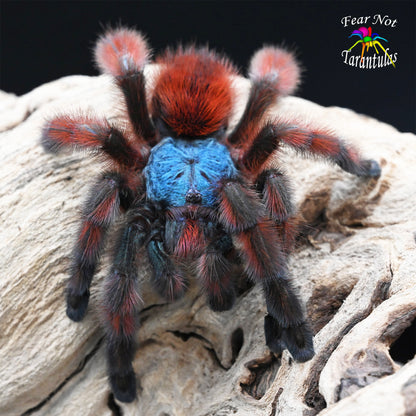
Caribena versicolor (Antilles Pinktoe Tarantula) about 1/2" - 3/4" *PLEASE SEE OUR TIPS FOR KEEPING THIS SPECIES UNDER THE DESCRIPTION.
Caribena versicolor (Antilles Pinktoe Tarantula) For sale! We offer 50 dram vials with extra ventilation drilled in them. They are perfect for this species and include substrate and foliage. https://fearnottarantulas.com/products/vial-extra-ventilation OR https://fearnottarantulas.com/products/tarantula-habitat-square-vial We feed our spiderlings red runner (Turkish roach) roaches. They are perfect for all sized spiderlings because they are soft bodied and are available in sizes from very tiny hatchlings on up to about 1". Check them out here! Fear Not Feeders Congratulations on adding one of the most beautiful and sought after arboreal species to your collection! We want to share some tips for the care of these spiderlings with you. Spiderlings of this genus tend to be a bit more delicate, but there are some things you can do to help ensure that your versicolor stays healthy. Housing: Your versicolor is still quite small and should be housed in a small habitat. In the wild they do not wander far from their webbing because they know it is risky for them to do so. They feel safe and secure within a small area where they have something to anchor webbing up high in the enclosure. Silk leaves work well for that because they are flexible. The enclosure cannot be too high or the spiderling will not be able to set up it’s webbing easily and will be stressed. Five to six inches is the tallest habitat it should go in. If a spiderling falls from a higher spot it could also get hurt and if this species is near molting it can be more difficult for it to climb up the sides of the habitat. It is important to have tiny leaves (such as ivy) in the enclosure to web on. They use small leaves to web them together. This also makes it easier to feed them. We highly recommend that you do not use an arboreal habitat that is upside down while this species is small. A 50 dram vial works well for a 1/2" - 1" spiderling. Feeding: Spiderlings from this genus tend to not venture downward in their enclosure to hunt for food. It is a good idea to try putting partially disabled food directly on their webbing for them. Many times they will take it directly from tongs or dull tweezers. If you are using a habitat that has been turned upside down (where the top is used as the bottom), it makes it difficult to accomplish this. Humidity: Lightly spraying the sides and a little on the webbing every 3 days or so is sufficient. If you see their habitat is maintaining humidity, you might consider drawing that out a bit. If you see condensation on the habitat walls, it is too humid.Thanks again and Happy Spidering!The Fear Not Team Additional care information can be found on Tom's Big Spiders https://tomsbigspiders.com/2019/08/02/caribena-versicolor-the-martinique-pinktoe/#more-5556 This is definitely one of the ‘prettiest’ tarantulas in the hobby. During the early stage of life, it is a beautiful bright metallic blue, fuzzy spiderling, and later becomes pink to red with a green metallic carapace. This is a good species for the beginner if a juvenile or adult is purchased. Spiderlings have some special care guidelines. The colors and fuzzy appearance of this tarantula often win people over to the hobby of collecting tarantulas. Name Pronunciation: Avicularia (uh-vik-yuh-LAH-ree-uh) versicolor (VUHR-suh-kuh-luhr) *Adapted from The American Tarantula Society Name and Description History: Aranea hirtipes Fabricius, 1787 Mygale hirtipes C. L. Koch, 1836 Mygale versicolor Walckenaer, 1837 Avicularia versicolor Simon, 1892 New World, Arboreal Size: 5” Growth Rate: Medium Natural Habitat: In the trees and shrubs of Martinique, Dominica, and Guadeloupe in the Caribbean. Housing Needs: Arboreal setup. Higher humidity is needed and can be obtained by misting every few days and adding cups of water to the habitat. Good ventilation is also important, especially for spiderlings. A tall piece of cork bark against a side of the enclosure is good to offer as something to anchor its web on. Temperament and Defensiveness: Versicolors are generally docile, but they do have urticating hairs which can be both kicked off and rubbed against a threat. They can also jump and bolt quite quickly. This genus has a unique defense mechanism by which they will launch excrement when they feel threatened. It can go as far as 2 or 3 feet. They also tend to jump, especially as babies and juveniles, and are particularly sensitive to breezes. If a spiderling escapes, hold your breath as you manipulate it back into the enclosure because the slightest breath will cause it to bolt. Feeding: If hungry, an adult will always take a large dubia right from my tongs.
Save on Caribena versicolor (Antilles Pinktoe Tarantula) about 1/2" - 3/4" *PLEASE SEE OUR TIPS FOR KEEPING THIS SPECIES UNDER THE DESCRIPTION. with a Fear Not Tarantulas, Inc. promo code
Checkmate is a savings app with over one million users that have saved $$$ on brands like Fear Not Tarantulas, Inc..
The Checkmate extension automatically applies Fear Not Tarantulas, Inc. discount codes, Fear Not Tarantulas, Inc. coupons and more to give you discounts on products like Caribena versicolor (Antilles Pinktoe Tarantula) about 1/2" - 3/4" *PLEASE SEE OUR TIPS FOR KEEPING THIS SPECIES UNDER THE DESCRIPTION..
Top Fear Not Tarantulas, Inc. discount codes
26 people have used this coupon code
Last used 2 months ago
HAP###########
10% Off When You Shopping
Last used 2 months ago
TT1####
11 people have used this coupon code
Last used 2 months ago
FNT######
See all codes

Similar items








